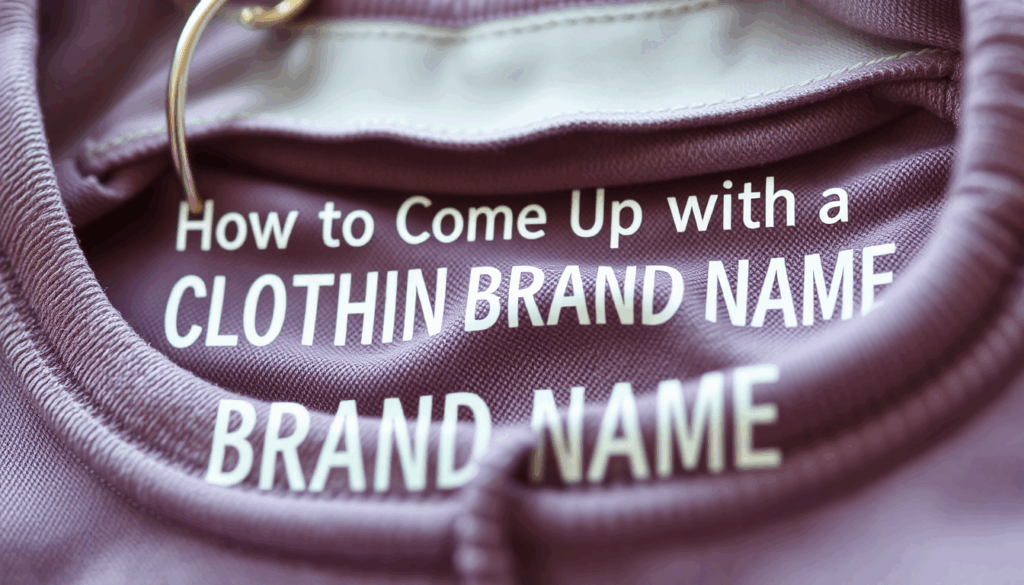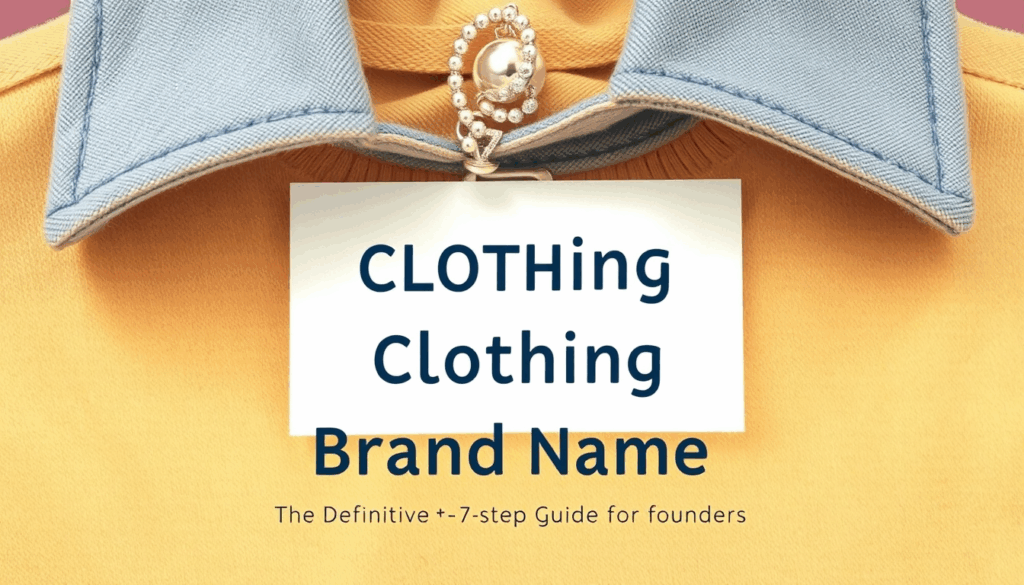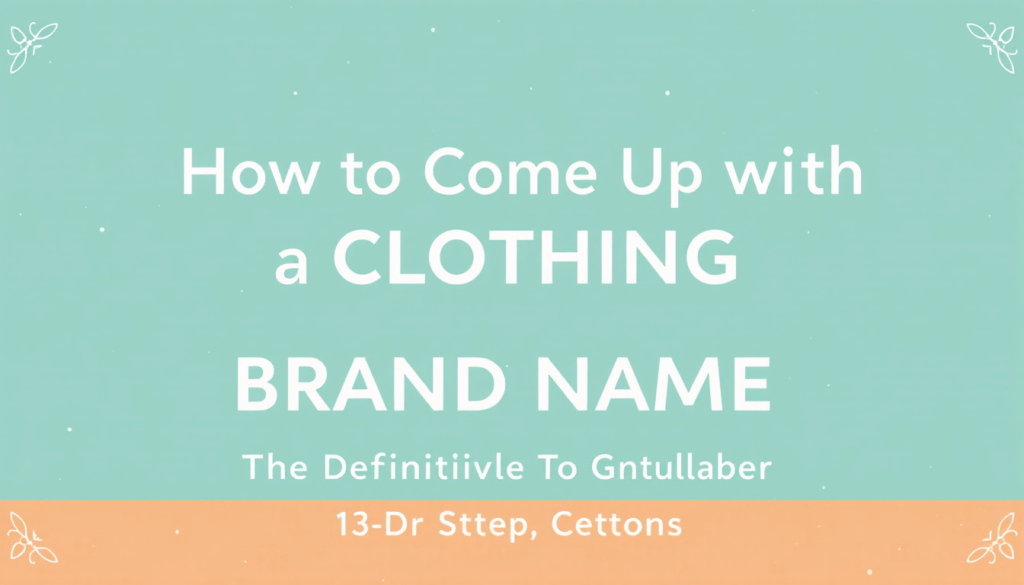The name of your clothing brand is one of the biggest decisions you’ll make as a founder. It’s more than just a label. Your brand name is your story’s foundation, your identity, and the first impression that customers engage with. The process requires both inspiration and cunning. This is where a lot of new business owners get tripped up. They choose names that are too generic, already in use, or don’t fit with their vision. This guide is unlike any other. We aren’t just going to give you a laundry list of random ideas to choose from. We will guide you through an established, 7-step process from simple strategy and all the way to your registration. Meaning that your chosen name is not only strong, easy to remember, but it is designed to stand the test of time.
Step 1: Define Your Brand’s DNA Before You Brainstorm
If the names that you jot down have no clear purpose, then this is similar to designing a dress with no apparent purpose. It results in boring ideas that don’t resonate with anyone. So what makes a powerful name? According to Siegel, a good strategy, not just one that’s personal or creative. So before you start jotting down possible names, you need to do some Brand DNA. This is why your brand is like no other.
What is Your Mission & Vision?
Why does your brand need to be in existence beyond the sole purpose of making money? This is the soul of your brand. A clear purpose makes it easy for people to resonate with what you’re doing.
- What change do you want to bring to the fashion world?
- How do you want customers to feel when wearing your clothes?
- What problem are you fixing? (like lack of eco-friendly luxury, need for adaptive wear, or making perfect basic items).
Who is Your Ideal Customer?
You’re not naming a brand for yourself alone. You’re naming it for the people who will buy from you. Dig deeper than merely age and gender to paint a more detailed picture of your customer.
- What do they care about and aim for in life?
- What other brands do they love (both fashion and other types)?
- How do they live their life? Where do they spend time, online and in the real world?
What is Your Niche & Brand Personality?
Your name should accordingly reflect your market position and that of your voice. The name of a luxury silk brand is going to land differently from an Agnes Martinian moniker for a skatewear line.
- Niche: Are you luxury, streetwear, simple, eco-friendly, tech-focused, or cutting-edge?
- Personality: Is your brand bold, fancy, fun, calm, tough, or smart? Answering these questions first gives you the filter you need for all the next steps.

Step 2: Choose Your Naming Strategy – The 5 Paths to a Perfect Name
“Most great brand names have a beat,” the pattern of branding, he said. Gardens generally fall into a couple of tried-and-true types. You’re more focused in your brainstorming if you choose a direction first. We have seen hundreds of brands enter. There are perhaps these five categories their names nearly always end up in.
| Naming Strategy | Core Idea | Pros | Cons | Example(s) |
| The Founder Name | Using a real or fictional person’s name. | Builds personal legacy, feels authentic, can sound high-end. | Can be hard to sell the business later, may limit scope beyond one person’s vision. | Chanel, Ralph Lauren, Tory Burch |
| The Descriptive Name | Directly describes the product, its benefit, or its origin. | Clear and straightforward, great for initial SEO, easy for customers to understand. | Can feel generic, difficult to trademark, may limit future product expansion. | The North Face, Allbirds |
| The Evocative Name | Suggests a feeling, benefit, or abstract brand story. | Creates strong emotional connection, highly memorable, very brandable. | Connection can be abstract, requires more marketing to build meaning. | Nike, Patagonia, Lululemon |
| The Invented Name | A completely new word, often a compound or modified word. | Highly unique, almost always easy to trademark and secure domains/handles. | Has no inherent meaning, requires significant marketing to educate customers. | Uniqlo (Unique Clothing), Adidas (from founder Adi Dassler) |
| The Symbolic Name | Uses foreign words, mythology, architectural terms, or metaphors. | Sounds sophisticated, tells a deeper story, can feel worldly and intriguing. | Meaning can be lost on the audience, potential for mispronunciation or cultural missteps. | Arcteryx (from Archaeopteryx), Veja (Portuguese for “look”) |
| Choose the strategy that best fits the Brand DNA you defined in Step 1. |
Step 3: The Creative Sprint – Generating Your Longlist
Strategy in hand, now the fun can begin. Now quantity over quality is the objective. Try to list 50-100 names without criticizing them. Even a “bad” idea will often kick open the door to a great idea. We know of entrepreneurs who have been bogged down looking for the one perfect name from day one. That’s a mistake. Our most successful client stumbled upon the name JJ Cole by combining two ‘bad’ ideas from their list and turning their combination into something great.” Don’t limit yourself yet.
- Mind Mapping: Start with your core DNA concepts (like “sustainability,” “urban,” “softness”) in the center and branch out with related words, feelings, and ideas.
- Word Association: Based on your chosen naming strategy, list words. For an Evocative name, list feelings (like Flow, Still, Echo). For a Descriptive name, list functions or materials (like Linen, Tech, Stretch).
- Thesaurus & Language Exploration: Use a thesaurus to find more interesting synonyms for your core concepts. If you’re using the Symbolic strategy, explore words in other languages (but always check meanings with a native speaker).
- AI Name Generators (for inspiration only): These tools can help get your creativity flowing. Use them to generate lots of ideas, then look for interesting word parts or concepts you can refine. Never rely on them for your final choice.
Step 4: The Validation Gauntlet – Culling the List and Finding “The One”
A great sounding name is useless if you can’t bring it to life. This is an essential step in the process and you’ve no other option but to pick a few favourites and road test them against real life. This makes a choice that is emotional into a choice based on facts.”
The Core Checks: Is it Available?
This is the most significant check to prevent later name changes or legal issues.
- Domain Name: Check if the .com domain is available. While other options exist, a .com still shows the most trust to customers.
- Social Media Handles: Check if the name is free on your main platforms (Instagram and TikTok are must-haves for fashion). Being the same across platforms is key.
The Legal Check: Is it Safe?
This is the most important check to avoid future name changes or legal problems.
- Understand the Difference: Registering your business name with the state is not the same as owning a trademark. A trademark protects your brand identity (name, logo) nationwide.
- Trademark Search: At minimum, you must search on the U.S. Patent and Trademark Office (USPTO) TESS database. Look for your name and similar variations.
- Business Name Search: Check your state and local business registries to make sure the name isn’t already taken, following the Small Business Administration (SBA) guidelines.

The Human Check: Does it Resonate?
A name needs to work in real life, not just on paper.
- Say It Aloud: Is it easy to say? Does it sound good? Avoid names that trip up your tongue.
- Spell It Out: Is it easy to spell after hearing it once? Hard spellings make it tough for customers to find you online.
- Get Feedback: Test your top 3-5 names on people who match your ideal customer. Don’t just ask friends and family, as they may be biased. Ask your target audience which name best fits a brand with your key traits. Use this simple Validation Scorecard for your top choices:
| Validation Point | Name Candidate 1: | Name Candidate 2: | Name Candidate 3: |
| Memorability (1-5) | |||
| Ease of Spelling/Pronunciation (1-5) | |||
| .com Domain Available? (Yes/No) | |||
| Social Handles Available? (Yes/No) | |||
| Initial Trademark Search Clear? (Yes/No) | |||
| Positive Audience Feedback? (Yes/No) | |||
| Final Score: |
From Name to Tangible Product: The Importance of a Good Manufacturing Partner
Now that you have a name that meets all your tests, it’s time for the fun part: bringing it to life. This is when your idea takes a true form, and your brand name has a permanent place to call home: on a label. This transformation from one idea to an actual piece of clothing is where so many new founders could use the help. At ChengLin Clothing, we are that guide. We’re an expert manufacturing partner to founders at this pivotal moment. We focus on helping startups to bring your new brand identity to life, from providing high-end woven labels and hang tags that can proudly display your new name which reflects your vision, to running small batch production which is ideal for those who are start-ups. We’ve launched hundreds of brands from scratch too, and we firmly believe your product quality needs to live up to the promise of your name. We are something more than just a supplier, we are your production partner. See how we help brands like yours get in the game with our custom clothing manufacturing services.
Step 6: Making It Official – Secure Your Brand Assets
As soon as your validation scorecard gives a definitive answer, you should act fast to lock down your brand identity. Don’t delay on this step. Branding unification across all channels can lift revenue by as much as 23%, so it’s essential to own your name across the board from the jump, Forbes says.
- Buy the Domain Name Immediately. Purchase the .com and think about buying common misspellings or other relevant TLDs (.co, .shop) to protect your brand.
- Register All Social Media Handles. Even if you don’t plan to use a platform right away, secure your brand name on Instagram, TikTok, Facebook, Pinterest, and X (Twitter).
- Register Your Business Name. Formally register your business as a sole proprietorship, LLC, or corporation under the new name with your state.
- File for a Trademark. This is the ultimate protection. While you can file yourself, we strongly suggest talking to a trademark attorney to ensure the process is done right and to understand the value of trademarking your most important asset.

Conclusion: Your Name is the First Chapter of Your Story
Picking a brand name can be daunting. A structured process removes it from the realm of guessing and into the world of strategic decision making. In adhering following to this framework – Strategy -> Creativity -> Validation -> Registration, you do things for a reason. The optimal name goes beyond Brand DNA and resonates with the intended customer and is legally secured. It’s the defining piece of your whole brand. Your brand name is not the destination, but the starting point in your narrative. Now go and write the rest of it. And while you’re drafting that next chapter, learn more about bringing your designs to life with a manufacturing partner who understands your journey from day one.
FAQ
- What are the 5 main strategies for creating a clothing brand name? The five main strategies are: The Founder Name, The Descriptive Name, The Evocative Name, The Invented Name, and The Symbolic Name.
- How important is domain availability when choosing a clothing brand name? Domain availability is crucial, with .com domains still showing the most trust to customers. It’s one of the first validation checks you should perform.
- Why should I define my brand’s DNA before brainstorming name ideas? Defining your brand’s DNA (mission, vision, target customer, niche) provides the essential filter needed to generate meaningful names that connect with your audience.
- How many name ideas should I generate before making a final decision? You should aim to generate 50-100 names without judgment during your creative sprint to ensure you have plenty of options to choose from.
- What legal steps should I take to protect my clothing brand name? After choosing a name, immediately secure the domain, register social media handles, register your business name with the state, and file for a trademark for complete protection.











